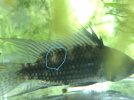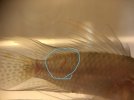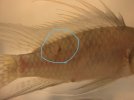Hi guys, I first noticed the skin lesion from my male A. cacatuoides about 3 weeks ago when he was still in the fry tank, it was a rather tiny dot back then. Since I have noticed him hunting on fries, I moved him to another community tank. After a week, I noticed the lesion has got slightly larger and I moved him to a hospital tank
I asked around while some people told me it's a kind of chronic columnaris and some told me he probably injured himself while hunting for fries. I was advised to add a combination of kanamycin and API furan2 but due to the ban of antibiotics in where I live, the closest I could find was a Nitrofuran class of medication. I dosed him for 3 days according to instruction and didn't seems like there's any improvement.
I read up on API website and it suggested a combination of medications and the shop owner also suggested me to try API melafix, so I dosed him for a week. The lesion didn't improve or worsen after that and I am planning to dose for another week according to the instruction. But I am wondering if anyone has the experience of treating fish lesion, does it look like columnaris and how long does it usually take for the fish to grow the scale back? He was active and eating during the whole treatment but I try not to feed too much, only around every 2-3 days with some frozen bbs.
The first picture was before treatment, second was after 3 days dose of nitrofuran, third was after API melafix. Thank you! Any help would be much appreciated.
I asked around while some people told me it's a kind of chronic columnaris and some told me he probably injured himself while hunting for fries. I was advised to add a combination of kanamycin and API furan2 but due to the ban of antibiotics in where I live, the closest I could find was a Nitrofuran class of medication. I dosed him for 3 days according to instruction and didn't seems like there's any improvement.
I read up on API website and it suggested a combination of medications and the shop owner also suggested me to try API melafix, so I dosed him for a week. The lesion didn't improve or worsen after that and I am planning to dose for another week according to the instruction. But I am wondering if anyone has the experience of treating fish lesion, does it look like columnaris and how long does it usually take for the fish to grow the scale back? He was active and eating during the whole treatment but I try not to feed too much, only around every 2-3 days with some frozen bbs.
The first picture was before treatment, second was after 3 days dose of nitrofuran, third was after API melafix. Thank you! Any help would be much appreciated.


